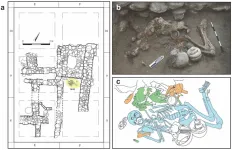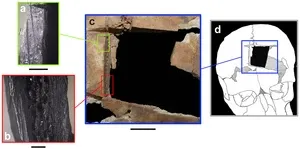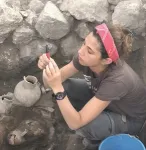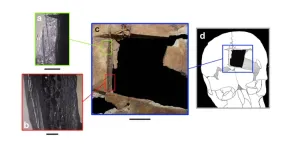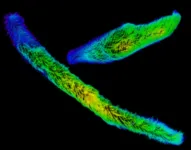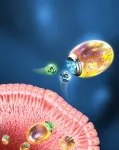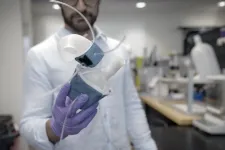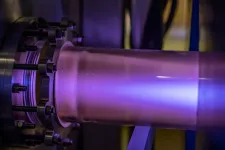(Press-News.org) Two high status brothers buried in a Bronze Age tomb in Israel were severely ill but apparently had access to rare treatments including trephination, according to a study published February 22, 2023 in the open-access journal PLOS ONE by Rachel Kalisher of Brown University, Rhode Island, and colleagues.
In this study, authors examined the remains of two individuals buried in a tomb beneath an elite residence in the archaeological site of Tel Megiddo in Israel. The tomb dates to the Late Bronze Age (around 1550-1450 BC), and DNA testing suggests the buried individuals are brothers. Both skeletons show evidence of disease, providing an opportunity to study how illness was treated during this time period.
Extensive lesions on the bones of both individuals are evidence of chronic, debilitating disease, possibly a condition to which the brothers shared susceptibility. The advanced state of the lesions indicates that, despite the severity of the condition, these individuals survived many years, possibly due to the privileges of wealth and status.
Additionally, one of the individuals has a ~30mm square hole in the frontal bone of the skull where a piece of bone was surgically removed, a procedure known as trephination which has been used to treat various medical disorders by relieving pressure buildup in the skull. This was likely intended to treat the patient’s ailment, but the lack of bone healing suggests the individual died during or shortly after surgery.
It is notable that the brothers’ tomb was adorned with high quality food and fine ceramics similar to other nearby high-status tombs. This suggests these individuals were not “othered” nor excluded from burial traditions due to their poor health. This serves as an important case study for continuing investigation into the intersections of status, illness, and treatment in societies through time.
The authors add: “Among the study’s multiple findings, we wish to highlight the special type of cranial trephination, the earliest of its kind in the region. This uncommon procedure was done on an elite individual with both developmental anomalies and infectious disease, which leads us to posit that this operation may have been an intervention to deteriorating health.”
#####
In your coverage please use this URL to provide access to the freely available article in PLOS ONE: https://journals.plos.org/plosone/article?id=10.1371/journal.pone.0281020
Citation: Kalisher R, Cradic MS, Adams MJ, Martin MAS, Finkelstein I (2023) Cranial trephination and infectious disease in the Eastern Mediterranean: The evidence from two elite brothers from Late Bronze Megiddo, Israel. PLoS ONE 18(2): e0281020. https://doi.org/10.1371/journal.pone.0281020
Author Countries: USA, Israel, Austria
Funding: The excavation of Burial 16/H/45 was funded by the Shmunis Family Foundation. In 2016 the Megiddo Expedition was also supported by the Dan David Foundation, Mr. Jacques Chahine and Mr. Mark Weissman. Finally, the purchase of the Leica microscope used in this study was possible through the support of the Society for Classical Studies, Women’s Classical Caucus. The funders had no role in study design, data collection and analysis, decision to publish, or preparation of the manuscript.
END
Two high status brothers had access to “brain surgery” in Bronze Age Israel
Both brothers suffered chronic illness, and one underwent rare trephination around 1500 BC
2023-02-22
ELSE PRESS RELEASES FROM THIS DATE:
Archaeologists uncover early evidence of brain surgery in Ancient Near East
2023-02-22
PROVIDENCE, R.I. [Brown University] — Archaeologists know that people have practiced cranial trephination, a medical procedure that involves cutting a hole in the skull, for thousands of years. They’ve turned up evidence that ancient civilizations across the globe, from South America to Africa and beyond, performed the surgery.
Now, thanks to a recent excavation at the ancient city of Megiddo, Israel, there’s new evidence that one particular type of trephination dates back to at least the late Bronze Age.
Rachel Kalisher, a Ph.D. candidate at Brown University’s Joukowsky ...
Keeping babies alive will lower population growth – new research
2023-02-22
Keeping babies alive will lower population growth – new research
New research showing high infant mortality rates are contributing to an incessant rise of the global human population supports arguments for greater access to contraception and family planning in low- and middle-income nations.
In an article published in PLOS ONE, research led by Professor Corey Bradshaw, Matthew Flinders Professor of Global Ecology from Flinders University and Peter Le Souëf, Professor of Paediatrics from The University of Western Australia has found that with higher baby death rates and larger household sizes (as an indicator of population density), ...
First transient electronic bandage speeds healing by 30%
2023-02-22
Wireless, battery-free bandage delivers electrical signals to help wounds heal
Bandage monitors healing, streaming data in real time to a smartphone or tablet
After healing is complete, bandage and electronics harmlessly absorb into the body
EVANSTON, Ill. — Northwestern University researchers have developed a first-of-its-kind small, flexible, stretchable bandage that accelerates healing by delivering electrotherapy directly to the wound site.
In an animal study, the new bandage healed ...
Giant proteins in a giant cell: Molecular basis behind fastest biological movement of single-celled eukaryotes
2023-02-22
In his famous letter to the Royal Society dated Oct. 9, 1676, Antonie van Leeuwenhoek described a single-celled eukaryote (Vorticella) and its fascinating ultrafast cell contraction as the first set of discoveries. This kind of ultrafast cell contraction triggered by a Ca2+-dependent mechanism is distinct from the adenosine triphosphate (ATP)-dependent mechanisms found in actin-myosin and dynein/kinesin-tubulin systems.
Spirostomum, is a genus of millimeter-scale single-celled protists that are known for their incredibly rapid movement like Vorticella. They are capable ...
Bow-and-arrow, technology of the first modern humans in Europe 54,000 years ago at Mandrin, France
2023-02-22
If the emergence of mechanically propelled weapons in prehistory is commonly perceived as one of the hallmarks of the advance of modern human populations into the European continent, the existence of archery has always been more difficult to trace. The recognition of these technologies in the European Upper Paleolithic has been hampered by ballistic overlaps between weapons projected with a thruster or a bow. Archery technologies are essentially based on the use of perishable materials; wood, fibers, leather, resins, and sinew, which are rarely preserved in European Paleolithic sites and make archaeological recognition ...
Climate change, urbanization drive major declines in L.A.’s birds
2023-02-22
Berkeley — Climate change isn’t the only threat facing California’s birds. Over the course of the 20th century, urban sprawl and agricultural development have dramatically changed the landscape of the state, forcing many native species to adapt to new and unfamiliar habitats.
In a new study, biologists at the University of California, Berkeley, use current and historical bird surveys to reveal how land use change has amplified — and in some cases mitigated — the impacts of climate ...
Twin-bioengine self-adaptive micro/nanorobots developed for gastrointestinal inflammation therapy
2023-02-22
Micro/nanorobots with self-propelling and -navigating capabilities have attracted extensive attention in drug delivery and therapy owing to their controllable locomotion in hard-to-reach body tissues.
However, developing self-adaptive micro/nanorobots that can adjust their driving mechanisms across multiple biological barriers to reach distant lesions is still a challenge.
Recently, a research team led by Prof. CAI Lintao from the Shenzhen Institute of Advanced Technology (SIAT) of the Chinese Academy ...
Custom, 3D-printed heart replicas look and pump just like the real thing
2023-02-22
No two hearts beat alike. The size and shape of the the heart can vary from one person to the next. These differences can be particularly pronounced for people living with heart disease, as their hearts and major vessels work harder to overcome any compromised function.
MIT engineers are hoping to help doctors tailor treatments to patients’ specific heart form and function, with a custom robotic heart. The team has developed a procedure to 3D print a soft and flexible replica of a patient’s heart. They can then ...
Professor Guido Kroemer will inaugurate Redox Medicine 2023 by Highlighting the Hallmarks of Aging & Redox Medicine
2023-02-22
The 25th International Conference on Redox Medicine, on June 21-23 in Paris, will revolutionize tomorrow’s medicine through redox. The translation of basic knowledge of redox into molecular medicine will be extensively discussed.
Prof. Guido Kroemer from the Université de Paris Cité, Hôpital Européen George Pompidou - AP-HP, is the key note speaker for this year. It is a great opportunity to share with Guido Kroemer his favorite topics and to have a unique moment of exchange with him.
Hallmarks of Aging & Redox Medicine: An Expanding Universe
Prof. Kroemer will highlight the “hallmarks of ageing: genomic instability, ...
WVU physicists give the first law of thermodynamics a makeover
2023-02-22
West Virginia University physicists have made a breakthrough on an age-old limitation of the first law of thermodynamics.
Paul Cassak, professor and associate director of the Center for KINETIC Plasma Physics, and graduate research assistant Hasan Barbhuiya, both in the Department of Physics and Astronomy, are studying how energy gets converted in superheated plasmas in space. Their findings, funded by a grant from the National Science Foundation and published in the Physical Review Letters journal, will revamp ...
LAST 30 PRESS RELEASES:
Structure of dopamine-releasing neurons relates to the type of circuits they form for smell-processing
Reducing social isolation protects the brain in later life
Keeping the heart healthy increases longevity even after cancer
Young adults commonly mix cannabis with nicotine and tobacco
Comprehensive review illuminates tau protein's dual nature in brain health, disease, and emerging psychiatric connections
Book prepares K-12 leaders for the next public health crisis
Storms in the Southern Ocean mitigates global warming
Seals on the move: Research reveals key data for offshore development and international ecology
Sports injuries sustained during your period might be more severe
World's first successful 2 Tbit/s free-space optical communication using small optical terminals mountable on satellites and HAPS
Can intimate relationships affect your heart? New study says ‘yes’
Scalable and healable gradient textiles for multi‑scenario radiative cooling via bicomponent blow spinning
Research shows informed traders never let a good climate crisis go to waste
Intelligent XGBoost framework enhances asphalt pavement skid resistance assessment
Dual-function biomaterials for postoperative osteosarcoma: Tumor suppression and bone regeneration
New framework reveals where transport emissions concentrate in Singapore
NTP-enhanced lattice oxygen activation in Ce-Co catalysts for low-temperature soot combustion
Synergistic interface engineering in Cu-Zn-Ce catalysts for efficient CO2 hydrogenation to methanol
COVID-19 leaves a lasting mark on the human brain
Scientists use ultrasound to soften and treat cancer tumors without damaging healthy tissue
Community swimming program for Black youth boosts skills, sense of belonging, study finds
Specific depressive symptoms in midlife linked to increased dementia risk
An ‘illuminating’ design sheds light on cholesterol
Who is more likely to get long COVID?
Study showcases resilience and rapid growth of “living rocks”
Naval Research Lab diver earns Office of Naval Research 2025 Sailor of the Year
New Mayo-led study establishes practical definition for rapidly progressive dementia
Fossil fuel industry’s “climate false solutions” reinforce its power and aggravate environmental injustice
Researchers reveal bias in a widely used measure of algorithm performance
Alcohol causes cancer. A study from IOCB Prague confirms damage to DNA and shows how cells defend against it
[Press-News.org] Two high status brothers had access to “brain surgery” in Bronze Age IsraelBoth brothers suffered chronic illness, and one underwent rare trephination around 1500 BC
